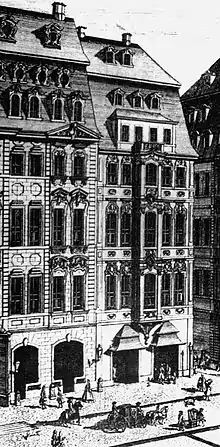Café Zimmermann
The Café Zimmermann, or Zimmermannsches Kaffeehaus was the coffeehouse of Gottfried Zimmermann in Leipzig which formed the backdrop to the first performances of many of Bach's secular cantatas, e.g. the Coffee Cantata (Schweigt stille, plaudert nicht), and instrumental works.

In 1723, the year Bach moved to Leipzig, it was the largest and best-appointed Kaffeehaus of Leipzig and a centre for the middle classes and gentlemen. While women were forbidden from frequenting coffeehouses, they could attend public concerts at Zimmermann's.[1] The coffeehouse was located at 14 Katharinenstrasse, then the most elegant street of Leipzig, connecting the Brühl to the market place. The name of the street had been taken from the old St. Catherine's Chapel which had been demolished in 1544. In Telemann's and Bach's day, only the name of the street remained.[2] During the summer months, Zimmermann also ran an outdoor coffee garden in the Grimmaischer Steinweg outside the city walls, near the East Gate.[3]
The four-and-a-half-story Baroque building was constructed by Doering around 1715. It consisted of two adjoining rooms, one approximately 8 by 10 metres (26 ft × 33 ft), the other approximately 5.5 by 10 metres (18 ft × 33 ft). It was destroyed during an Allied air raid on Leipzig in December 1943.[4]
Zimmermann also ran a coffee garden as a summer venue.
Music
From 1720 the café hosted the Collegium Musicum founded by Georg Philipp Telemann as a law student in 1702.[5] It was later directed by Johann Sebastian Bach between 1729 and 1741, with a break between 1737 and 1739, while his former student Carl Gotthelf Gerlach stood in for Bach. The concerts directed by Bach lasted about two hours and consisted of German and Italian opera, chamber music, secular cantatas, and works for orchestra.[6] Zimmermann charged the Collegium Musicum no fee for hosting their concerts, nor were the audience charged a fee; Zimmermann's expenses were repaid by sales of coffee.[7] The concerts ended with Zimmermann's death in 1741.
The French classical music ensemble Café Zimmermann is named after this coffeehouse.
References
- "Schweigt stille, plaudert nicht". bach-cantatas.com. Retrieved 28 December 2014.
- Wolfgang Hocquél; Peter Franke (1998). Leipzig. Stadtansichten. p. 59. "Die Katharinenstraße hat ihren Namen von der mittelalterlichen Katharinen-Kapelle erhalten, die sich einst an der Ostecke Brühl/Katharinenstraße 24 befunden hat und im Zuge der Reformation im Jahre 1544 abgebrochen wurde."
- Stauffer, George B. (2008). "Music for "Cavaliers et Dames": Bach and the Repertoire of His Collegium Musicum". In Butler, Gregory G.; Stauffer, George B.; Greer, Mary Galton (eds.). About Bach. University of Illinois Press. pp. 135–156. ISBN 0-252-03344-2.
- George B. Stauffer, "Civic Life and Secular Music Making, Leipzig: a Cosmopolitan Trade Centre" in Music and Society: The Late Baroque Era, From 1680s to 1770 (Englewood Cliffs, New Jersey: Prentice Hall, 1993
- Bruce Haynes – The eloquent oboe: a history of the hautboy 1640–1760, p. 364 (2001) "Telemann became director in 1702, and members of the Collegium Musicum he founded in that year supplied many of the musicians. The Collegium Musicum was one of a number of concert series in Leipzig, a city with a large music-loving [population]."
- Kelly, Thomas Forrest (2012). Music Then and Now. Harvard University. pp. 154–155.
- Iso Camartin, Bin ich Europäer?: Eine Tauglichkeitsprüfung, pp. 75, 2006. "Gottfried Zimmermann war ein Kaffeehausbesitzer, der seine Räumlichkeiten von 1720 bis zu seinem Tod 1741 gern den musikalischen Ensembles der Stadt zur Verfügung stellte. Die Zuhörer bezahlten keinen Eintritt, sie tranken dafür Kaffee."